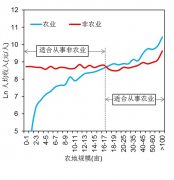本文为美国爱荷华大学(作者:Luciana Kindl da Cunha)的博士论文,共266页。
星载遥感数据集有可能使我们朝着全球范围的洪水预报系统迈进。然而,这些数据集在时空分辨率和精度方面受到限制,要想最好地利用这些数据,就需要了解不确定性是如何通过水文模型传播的。水文模型不同的数据集无偏调查需要一个简洁的无标定模型,因为标定掩盖了数据和模型结构中的不确定性。
本研究包括两个部分:1)多尺度分布式水文模型的开发和验证,该模型的参数可直接与流域物理性质联系起来,从而避免了校准的需要;2)应用该模型来演示数据不确定性是如何传播的,通过模型和影响尺度进行洪水模拟。我的模型开发基于一种交互式的建模方法,通过系统地增加过程,评估了它们对多尺度洪水预报的影响。为了避免参数校准的需要,表示物理过程的复杂性水平受到数据可用性的限制。应用这个模型来模拟位于爱荷华州的雪松河、爱荷华河和土耳其河流域的水流,选择这个地区是因为它有丰富的高质量水文信息,可以用来验证模型。此外,该地区经常被洪水淹没,是2008年夏季极端洪水事件的中心。通过模拟中高流量条件演示了模型建立的技巧;但是,对于干旱(低流量)条件,模型的性能相对较差。低流量时模型性能差的原因是模型中没有考虑土壤和蒸散的高度非线性动力学。应用水文模型研究了卫星数据集的可预测性,并研究了该模型对某些水文气象变量(如初始土壤湿度和蒸散偏差)的敏感性。河网结构和降雨是形成洪水的主要组成部分,这两个变量都是从空间上监测的。评估了不同的DEM来源和分辨率DEM,以及修剪小阶河道对系统性降低排水密度的效果。结果表明,修剪河网对模拟洪峰流量的影响大于DEM分辨率或来源,说明了正确表示河网的重要性。洪水预报误差取决于流域尺度和降雨强度,随流域尺度和降雨强度的增大而减小。在降水情况下,由随机误差(空间相关与否)和粗时空分辨率引起的模拟洪峰流量不确定性是无标度的,并且随着流域尺度的增大,过程线误差减小。这一特征很重要,因为它揭示了一个尺度,在这个尺度上,不太准确的信息仍然可以用来预测洪水。然而,对真实数据集的分析揭示了其他类型误差的存在,如总体积的主要总体偏差和未能检测到对于洪水预报至关重要的显著降雨事件。
Space-borne remote sensing datasets havethe potential to allow us to progress towards global scale flood predictionsystems. However, these datasets are limited in terms of space-time resolutionand accuracy, and the best use of such data requires understanding howuncertainties propagate through hydrological models. An unbiased investigationof different datasets for hydrological modeling requires a parsimoniouscalibration-free model, since calibration masks uncertainties in the data andmodel structure. This study, which addresses these issues, consists of twoparts: 1) the development and validation of a multi-scale distributedhydrological model whose parameters can be directly linked to physicalproperties of the watershed, thereby avoiding the need of calibration, and 2)application of the model to demonstrate how data uncertainties propagatethrough the model and affect flood simulation across scales. I based the modeldevelopment on an interactive approach for model building. I systematicallyadded processes and evaluated their effects on flood prediction across multiplescales. To avoid the need for parameter calibration, the level of complexity inrepresenting physical processes was limited by data availability. I applied themodel to simulate flows for the Cedar River, Iowa River and Turkey Riverbasins, located in Iowa. I chose this region because it is rich in high qualityhydrological information that can be used to validate the model. Moreover, thearea is frequently flooded and was the center of an extreme flood event duringthe summer of 2008. I demonstrated the model’s skills by simulating medium tohigh-flow conditions; however the model’s performance is relatively poor fordry (low flow) conditions. Poor model performance during low flows isattributed to highly nonlinear dynamics of soil and evapotranspiration notincorporated in the model. I applied the hydrological model to investigate thepredictability skills of satellitebased datasets and to investigate the model’ssensibility to certain hydro-meteorological variables such as initial soilmoisture and bias in evapotranspiration. River network structure and rainfallare the main components shaping floods, and both variables are monitored fromspace. I evaluated different DEM sources and resolution DEMs as well as theeffect of pruning small order channels to systematically decreasing drainagedensity. Results showed that pruning the network has a greater effect onsimulated peak flow than the DEM resolution or source, which reveals the importanceof correctly representing the river network. Errors on flood prediction dependon basin scale and rainfall intensity and decrease as the basin scale andrainfall intensity increases. In the case of precipitation, I showed thatsimulated peak flow uncertainties caused by random errors, correlated or not inspace, and by coarse space-time data resolution are scaledependent and thaterrors in hydrographs decrease as basin scale increases. This feature issignificant because it reveals that there is a scale for which less accurateinformation can still be used to predict floods. However, the analyses of thereal datasets reveal the existence of other types of error, such as majoroverall bias in total volumes and the failure to detect significant rainfallevents that are critical for flood prediction.
1. 引言2. 无标度水文模型的建立3. 模型应用4. DEM源、分辨率和网络修剪对河网特征和跨尺度洪峰流量大小和时间估计的影响5. 雷达降雨误差结构对跨尺度洪水预报的影响6. 降水分辨率和采样间隔对洪峰流量模拟的影响7. 不同降水数据集的评价及其对洪水预报的影响8. 蒸散量和土壤水分初始条件对洪峰尺度的影响9. 结论与进一步研究的建议附录 网络水力几何

